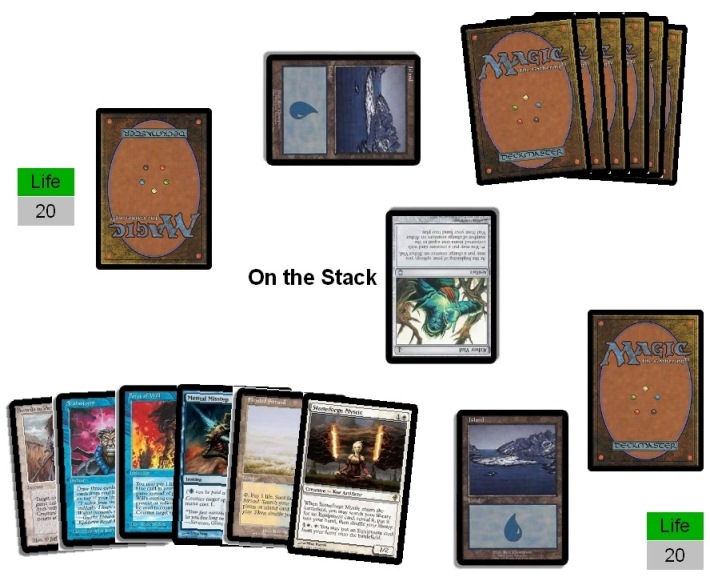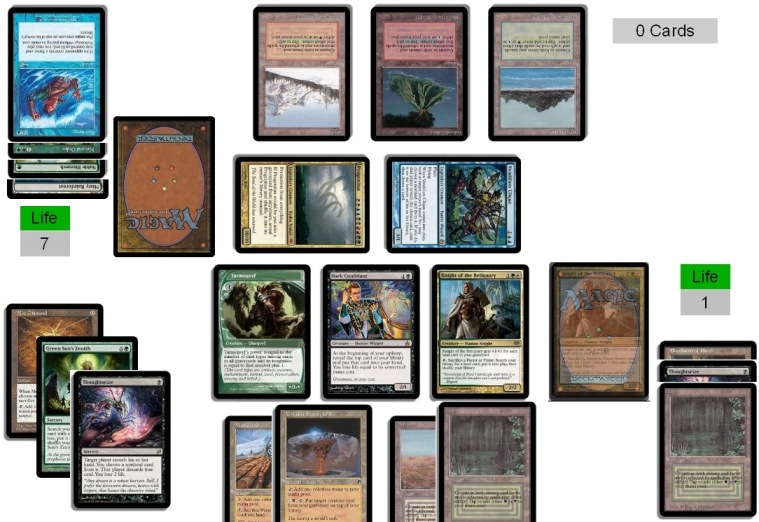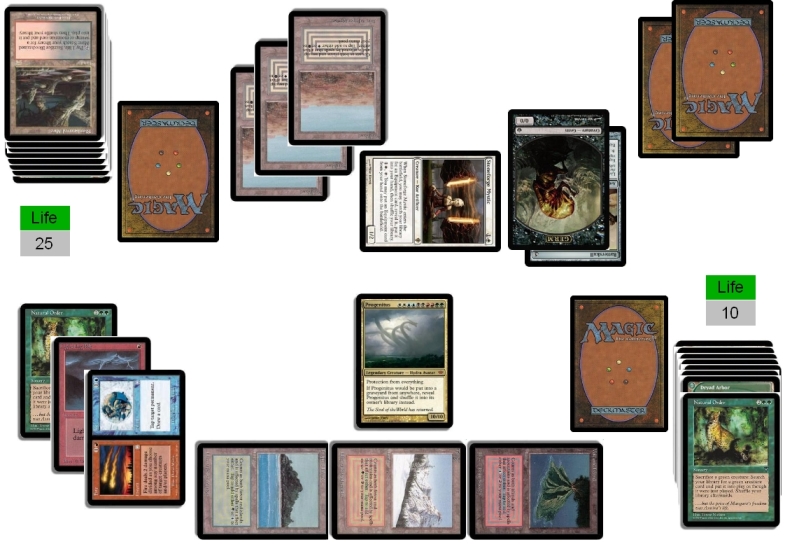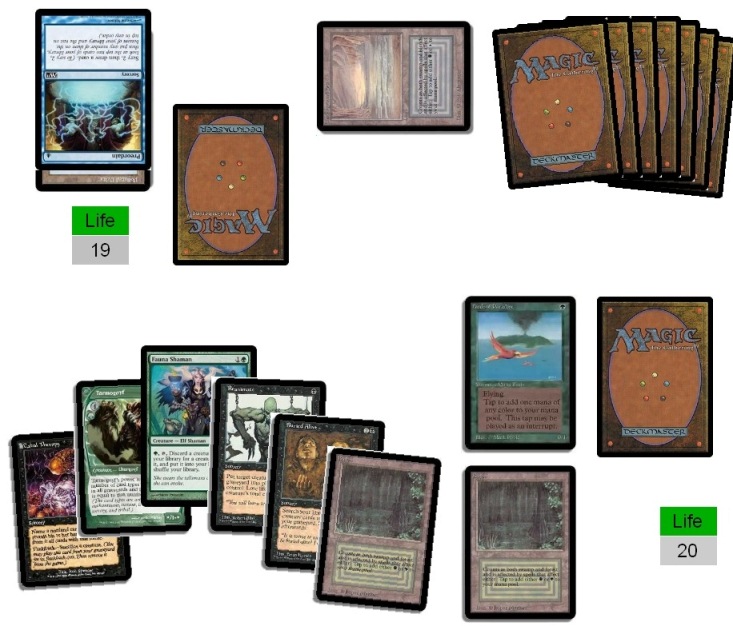Legacy is huge—there are more decks and interactions than you’ll see come up in any other format. While Vintage might technically have more legal cards, the power level of the format keeps a lot of things that are viable in Legacy from ever seeing play. For someone who wants to get into the format, this is obviously a daunting perspective. At the same time, Legacy’s awesome variety is one of its biggest pulls. As a result, learning Legacy like you learn other formats, by building a small gauntlet with the best decks and jamming games, is never going to prepare you for what you’re actually going to encounter at a tournament.
In addition, there is a difference in the amount of available plays that can be quite staggering. There are many subtle plays that come up in Legacy that I’ve rarely or never seen come up in smaller formats. These subtle plays and the amount of convoluted thinking necessary to find them are part of what makes Legacy such a skill-intensive (and fun) format. Because there are so many of them, and because most are very situational, it’s relatively useless to try and list them or describe particular examples. Instead, you need to develop a particular mindset and the habit of looking for minor interactions that can be exploited for some valuable gains.
During the talent search, I wrote an article that aspired to teach people how to play control. As I find that a similarly difficult endeavor—game states and game plans are generally more fluid when playing control—what I did instead of trying to explain things in general terms was to create in-game situations for people to evaluate, followed by detailed reasoning explaining what I considered to be the correct play. The article was the best-liked one I wrote, as people seemed to have a lot of fun figuring out optimal lines of play. I promised to do something similar again, and considering that the problems posed by initiating players to the feel of the Legacy format are similar to those related to developing a control player’s mindset, today is the day I deliver on that promise. Enough introduction—time to get going!
Misstepping 101
Let’s start of with an easy one:
You’re playing a U/W Stoneforge control deck and are on the play. Having simply played an Island and passed on your first turn, your opponent makes a more proactive play:

As I said, this one is the warm-up. Clearly, we want to Misstep that Vial and there’s only one choice to make: do we cast it using life or mana. Now most people that are at all familiar with Legacy will automatically put their opponent on Merfolk when they see Island into Vial, conclude the opponent has Daze and pay two life to play around it. After all, if they have the Daze, they’ll get their Vial down and we’re screwed, right?
Or are we? If they Daze here, they set themselves back to zero lands and a Vial, meaning they’ll be slow coming out of the gates, Vial or no. If Daze is out of the picture because it was (or would likely have been) used on the Misstep, our Stoneforge Mystic backed by Force of Will is almost definitely going to resolve, and they won’t hit a two-drop of off either Vial or their lands before Batterskull is already swinging in. With Swords to Plowshares for backup, the chance of them making a comeback in that situation is rather slim, even with an effect as powerful as Vial’s at their disposal.
As you can see, it would sure be nice to stop that Vial, but drawing out the possible Daze here is actually much more valuable in the context of how we want this game to go. I wrote an article about playing around Daze and friends before—this would be one of the situations I described as “baiting Daze.”
Another thing of note is that the necessity to bait that Daze here is reinforced by the fact that we don’t have a third land to play yet, meaning there is a reasonable chance we won’t be able to slowroll our Stoneforge Mystic for a turn to play around it anyway. Even with the third land available, trying to set up the turn 2 Mystic is much stronger than waiting for turn 3. Every turn that goes by before Batterskull hits play makes it more likely for them to Voltron up an army of lords that trumps the mini-Baneslayer. It’s time to proudly “misplay” into the Daze.
All the Cards in the World
You’re playing Zenith Junk, very slightly modified from the linked list, against NO RUG. After two hard-fought duels it all comes down to this: your opponent’s fast Progenitus has turned your Dark Confidant into more of a liability than anything else. His attack has left you at only a single life and to add insult to injury, your opponent used his sideboarded Submerge to put your Knight of the Relinquary back on top of your library after you had resolved its ability at the end of turn, aiming to have you dead to your own Bob Maher, Jr. Is there a way out?

Do you feel like this is an episode of Magic: The Puzzling yet? Because yes, there is a way for you to win this game no matter what. Can you find it?
Â
WAIT
Â
FOR
Â
IT
Â
The do-or-die aspect of the situation that would make it stressful if encountered during an actual match also happens to make it comparatively easy to solve through reasoning. There really isn’t much choice involved, and any play comes from necessity instead of being based on judging what is likely to deliver the highest benefits.
The first thing we need to do is survive the Dark Confidant trigger. With the resources at hand, we could use the remaining Knight to shuffle our library so as to at least have a chance to hit a land instead of the Submerged Knight. That still leaves us with a more than 50% chance of dying, though.
The key to improving on that chance is knowing that this is a Green Sun’s Zenith deck and as such runs a zero-cost creature: Dryad Arbor. If we can get Arbor into the graveyard, Volrath’s Stronghold will allow us to put it on top, ready to be flipped by Confidant. The Wasteland we have in play means getting the Arbor into play is enough to achieve that purpose, and the active Knight luckily is perfectly able to find the Arbor for us. Surviving Bob at 1 life? Easy as pie!
Despite living to see our main phase, we aren’t out of the woods yet. If we don’t win this turn, Big Daddy Progs and Wendy (-lion Clique) are going to kill us, sweet upkeep shenanigans or not. With Knight tapped, Tarmogoyf plus Bob represent only six damage. Can we really only put our opponent to one and have to lose after all this?
Obviously I’m not that mean. Enter Mox Diamond. Other than being a mana source, it also happens to be the perfect tool to pump Tarmogoyf in games without dead artifacts. We just play it, refuse to discard the land and, voila: 5/6 Goyf. Swinging for the win has rarely felt that satisfying.
Predicting the Future
In this example, the focus is less on the exact correct play: instead, you’re asked to envision how the game could progress from here and plan accordingly, a skill that is relevant to every format but particularly useful in Eternal. The high number of cantrips and other library manipulation being played makes it much easier to see where things might be going and work towards particular outs. Note that this situation isn’t a theoretical construct I’ve created but an actual in-game situation shared by Jona on the Source, which is also the reason we don’t know the exact contents of both graveyards. For our decklists, we’ll assume he was running Alex Bertoncini’s list from SCG Open Cincinnati as I don’t feel like cluttering the article with decklists that are two or three cards off a standard list in addition to the pictures.
Time has been called during your opponent’s turn after his Batterskull and Stoneforge Mystic swung in and put the life totals at 25 — 10 in his favor, smugly assuming he was going to win. You finally drew your fourth land and cast Natural Order, sacrificing Dryad Arbor and leaving you on three lands. This is the board after the Natural Order has resolved:

The opponent states that the game is now a draw. Do we take him up on his implied offer and save the trouble of playing it out? Why (or why not)?
WAIT
Â
FOR
Â
IT
I would never take the draw here as we’re actually very likely to win this game and it’s nearly impossible for us to lose—him calling the game a draw implies that he can’t get rid of Big Daddy Progs. We admittedly have to hope he draws blanks because we won’t win through any actually relevant spell he casts, but his statement about the draw luckily makes it pretty clear his hand doesn’t have anything that matters. By the way, do you see how much information can be gleaned from this seemingly simple statement? If you needed a reason to keep your mouth shut, you now have one.
Assuming he does draw blanks though, there are a number of cards we can draw next turn that will allow us to win the game. Let’s check it out:
If we draw:
Any non-Arbor land then we attack with Progenitus, Natural Order again for pseudo-vigilance,* swing once more next turn and burn him out for exactsies. Protection from everything does many things, including nullifying the lifelink ability granted by Batterskull.
*Yes, you can actually sacrifice Progenitus to Natural Order for itself again.
Any burn (including Grim Lavamancer then we attack with Progenitus, Ice the Germ on his turn, and cast Bolt during the end step. If we drew Lavamancer, we obviously had to cast that instead. Then simply attack again and burn him out with whatever we drew.
A Green Sun’s Zenith gives us options. If we assume he’s bad, we can Zenith out a Tarmogoyf and attack with Progenitus. If he doesn’t attack back into Goyf, we just swing with Progenitus and burn him out as if we had drawn a land. If he attacks back with both guys, Goyf kills the Germ and our opponent goes to 19 while we take one from the Mystic. After that, we attack with Goyf and Progenitus, then burn him out—if Goyf isn’t 4/5 yet, cast Bolt first.
If we expect him to keep Stoneforge Mystic back to block while attacking with the Germ like he should, then the above line of play turns the game into a draw if Goyf isn’t at least 6/7—at which point we can kill or tap Mystic and attack with Progenitus and Goyf, followed by Bolt for the win.
Assuming Goyf is too small, if we truly want to play for the win (always a good idea) we have to Zenith for Dryad Arbor and attack with Progenitus. If he attacks back, we block the Batterskull and Fire our own token to fizzle the lifelink, as well as his face (24). Now a burn spell, Hierarch, or another Zenith (for Hierarch) do enough off the top. Alternatively, we could Ice the Germ instead of blocking and casting Fire, which would allow us to draw an additional card but reduces our outs to just burn spells; the correct play depends on what exactly is left in our deck.
A Tarmogoyf then we play it and are essentially in the same situation as if we’d Zenithed for Goyf, though we have one more red mana. An end step Bolt, followed by drawing another burn spell next turn, wins us the game even if Goyf is too small to win on its own and our opponent correctly trades his Germ for four life.
A Hierarch lets us gain exalted and swing with Progenitus for eleven. We then Ice the Germ, swing for eleven again, and Bolt him out.
Any cantrip will let us win if we can hit either a fetchland, Dryad Arbor, or a burn spell. Depending on which we get, we either follow the scenario for drawing burn or the one for GSZ, treating the fetch plus cantrip as Zenith for zero. Note that Grim Lavamancer isn’t an out here due to our red mana situation.
A blank, such as countermagic, Clique, or Sylvan—actually much less likely than drawing business—require an attack with Progenitus, Ice the Germ on his turn, and hope to draw burn of off either Ice or our next draw step. We should Bolt here again during the end step to free up mana for possible cantrips on the following turn.
This leaves us with a large number of options to win the game, as well as multiple ways for our opponent to throw away the game—not wanting to trade the Germ for four life against a Goyf seems like a particularly likely misplay. Much better odds than just taking the draw, I’d like to think. The beauty of it is that even if the opponent has something meaningful, it only turns the game back into a draw or puts us back on the “draw burn” plan. There is essentially no way we can actually lose.
The (Second) Deepest Card in the Format
You’re on the play with Ken Adams’s BG Buried Alive deck from the last Baltimore Open against an opponent you know to be very good, though you don’t have any idea what he’s playing today. After you started with Bayou into Birds of Paradise, your opponent has gone Polluted Delta into Underground Sea and Preordain, keeping both on top. It’s your first main phase:

What do you do and why?
Â
WAIT
Â
FOR
Â
IT
Â
The correct line here is as follows: cast Cabal Therapy naming Dark Ritual. If that guts the opponent’s hand enough to stop a win, even adding what will clearly be a good topdeck, we drop Fauna Shaman and say go. If he still threatens to go off, we’ll need to drop Tarmogoyf and sacrifice it to flashback Therapy on whatever will stop that.
Seem complicated to justify all this from such a minor amount of information? Let’s take a look at the reasoning process.
The first thing of note is that we have a huge variety of plays available. Buried Alive for the Ooze-combo here will allow us to cast Reanimate next turn and just win. Fauna Shaman allows us to threaten a slower way to either combo or grind the opponent out with Bloodghasts and Vengevines. Tarmogoyf is already a 2/3 and likely to grow larger soon enough, especially if we plan to flashback the Cabal Therapy that sits in our hand or to cast Buried Alive next turn. All of these are plans appropriate for particular situations—the question is which one we need to follow against this particular opening.
The first thing to do is figure out what our opponent is up to. The fact that he went Polluted Delta into Underground Sea isn’t telling without further consideration, as many two-color decks just run whatever blue fetchlands after having maxed out the fully on-color ones, not to mention everything from UBW Stoneforge through Team America and BUG Control to Ad Nauseam has this opening available.
Our true clue here is the Preordain. There are very few decks that have room to include cheap cantrips beyond Brainstorm and Ponder, the most prominent of which are ANT and Spiral Tide. Of these, only ANT is likely to even have an Underground Sea in their deck.
ANT has a solid chance to just win on the second turn, and there are two facts that make it likely he will indeed be able to do so. The more obvious one is that he went top, top with Preordain. Assuming the opponent didn’t keep a bad hand—and we’ve figured him for a good player, so that seems unlikely—hitting all gas like that should just end things if he’s left unmolested.
In addition, our opponent chose to fetch an Underground Sea on turn 1 against our play of Bayou, Birds of Paradise. Most decks that have Bayou also have Wasteland, and opening yourself up to getting Wasted in ANT when you can avoid it is generally bad play. Even if you don’t have a black source yet, getting an Island to make sure you can keep cantripping until you do is usually a better plan. The opponent going for Sea anyway tells us that he either isn’t afraid of Wasteland (there is even an outside chance that he actually wants to get Wasted so as to get closer to threshold for Cabal Ritual) or is low on lands but needs black mana on turn 2.
The only reason ANT would need black mana on turn 2 against a deck with Bayou and Birds in it is to win, though. There are exactly two kinds of spells in ANT that need black mana: discard and the Rituals/business used to win. Discard is only necessary against decks that can actually counter their spells—generally not decks with Bayou and Birds in them—so in all likelihood the black mana is meant to cast acceleration for the win.
At that point, it is overwhelmingly clear that to try and stop him is where it’s at, as Buried Alive into “we die” isn’t exactly a brilliant plan. Our only disruption being Cabal Therapy, our line is clear. What to name, though?
We really need to hit twice, as just a single effective discard spell isn’t likely to get us there if we have to sacrifice part of our clock to make it happen. Therapy blind, we obviously want to name a four-of, as those are the things most likely to be in his hand. It also has to be something that would lead to a win next turn, so our options are essentially Dark Ritual, Cabal Ritual, Lion’s Eye Diamond, and Infernal Tutor.
Cabal Ritual is the first exclusion, as it is much weaker than Dark Ritual considering how far he is from threshold.
LED is the next thing I’d exclude. Bayou will signal “discard” to most players, and the best plan for Storm against that angle of attack is to drop their artifact mana into play as soon as possible so as to enable an Ad Nauseam for the win off any drawn tutor, independent of how much their hand was shredded. As there is no LED in play, there probably isn’t one in our opponent’s hand either. Note that this decision hinges a lot on knowing our opponent is good.
This leaves us with Infernal Tutor and Dark Ritual for choices, and Preordain works as the tiebreaker here. As there are generally only six tutors in ANT, they are the scarce resource and what a good player would usually most want to protect against discard and therefore leave on the top of his deck with Preordain. So we name Dark Ritual.
Now it’s entirely possible the opponent already had a Tutor or even Ad Nauseam in his hand, and Preordain just found the necessary mana to use those cards—but we don’t have any reason to assume that is the case, meaning he is more likely to have the Ritual than the Tutor just because of the fact that he played Preordain the way he did. In that case, we’ll have to bite the bullet and Therapy again, essentially turning a creature in our hand into a Duress.
Phew, that was a lot of analysis for a single play. Cabal Therapy is considered to be one of the most skill-intensive cards in existence for a reason. The rest of the turn is a bit more straightforward, though there are a number of different lines that are correct depending on what we see/hit with Therapy.
If Therapy stops the possible combo next turn, then we drop Shaman because that will either set up our own combo all by itself between two and three turns from now, depending on what we draw—a creature allows us to get Quirion Ranger to speed up the win. We could also simply win with Buried Alive/Reanimate if the opponent doesn’t have any discard.
If we do have to Therapy again to keep the opponent from winning, but he doesn’t have a discard spell, then we cast Goyf and sacrifice that because it is unlikely to ever provide a relevant clock—it generally won’t be bigger than 4/5 in this matchup until we’re dead, meaning we’re looking at a four/five-turn clock—while the Birds of Paradise allows us to just win of off Buried Alive/Reanimate if we topdeck a land next turn..
Finally, if we have to Therapy again and they do have discard, we still want to keep the Shaman available because a topdecked creature will lead to us comboing before Goyf would win or combine with the Buried Alive to make Vengevines two turns from now, while topdecking anything else will allow us to use either Reanimate or Buried Alive (depending on what the opponent hits with discard) to create a clock that is as fast or faster than the one Goyf delivers anyway.
School’s Out
There are many other examples and subtle plays that would be instructive or interesting to cover, but I have to stop at some point. I’ll do something like this again if I get the impression you enjoyed it. For today, I hope you’ve learned something about the wide range of plans and situations that regularly figure into Legacy gameplay. With how wide open Legacy is, being able to think about these kinds of plays on the fly without losing track of all the minor value plays necessary to milk every turn for maximum possible gain is what really leads to success in the format.
Did you find the answer for all these scenarios? Is there something you didn’t understand, or maybe you simply disagree with the courses of action I have suggested? Either way, let me know and share what you have to say with the rest of the internet. Nothing but good can come from honing our reasoning skills. Until next time, think outside the box!
Carsten Kötter
